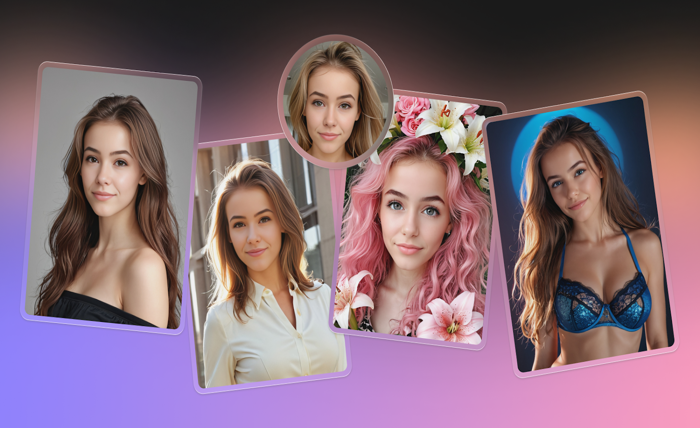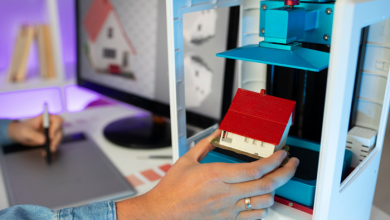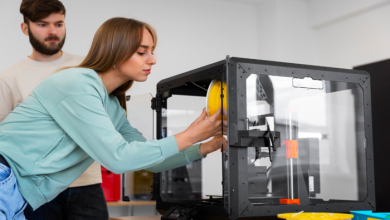
Open a photo with people in it. Pick a new face. Get back the same shot, same lighting, same clothes, same camera angle, but with different identities. That is the promise. Icons8 built Face Swapper to hit that exact use case. Not for jokes. For real creative work that has to survive client decks, paid social mockups, and internal reviews.
Face Swapper runs in the browser and in the mobile app version that Icons8 shipped to Google Play in late July 2025. No installer. No GPU drama. Anyone on the team can try it. That detail alone changes how fast creative teams move, because it cuts out the one bottleneck almost every studio knows. There is always exactly one retoucher who knows how to blend faces convincingly. When that person is offline, nobody ships. Here, a marketer can generate a variation without opening Photoshop.
What the tool actually does
The workflow is simple enough that non technical teammates can use it without asking for help. You upload the base shot. Could be a studio portrait, a team photo from a company offsite, a campaign hero visual with models holding the product. The service scans the frame and finds each face on its own. It identifies landmarks like jawline, cheekbones, lip line, and eye corners, which tells it where the head is turned and how the mouth is shaped.
Then you provide a donor face. That can be you, your coworker who agreed to appear in marketing, licensed talent, or one of the sample faces from the built in gallery. The system takes that donor identity, bends it into the pose of the original subject, harmonizes tone and lighting, and stitches it in. You download the result at the same resolution as the source.
Icons8 calls out that it handles more than perfect front facing selfies. It will attempt side angles, three quarter turns, tilted heads, partially covered faces, hair in the way, facial hair, glasses, hats. Those are exactly the shots that normally fail in cheaper face apps. You also get Multiswap, which means you can swap more than one person in a single frame in one run instead of repeating the process over and over. Marketing teams who localize the same lifestyle photo for five regions immediately understand why that matters.
The service keeps resolution. Icons8 advertises support for faces up to 1024 by 1024 pixels and says it returns the image at the same size and quality you uploaded. In plain English, you are not forced to accept a tiny blurred output. You can drop the edited shot into a Figma board or a pitch deck and it will not scream low effort filter at first glance.
There is also a retouch mode that behaves like restrained cosmetic cleanup. You feed the same face back into its own photo and ask Face Swapper to fix skin, blemishes, redness and small symmetry issues without changing the person. Photographers and social media managers use this constantly for minor corrections on headshots and speaker photos. When a client asks for light cleanup fifteen minutes before something goes live, this is how you avoid reopening a full retouch session.
What is happening under the hood
Underneath the point and click interface, Face Swapper is running the same general pipeline you see in modern identity transfer systems.
Step one. Detect and align every face in the scene. A convolutional neural network finds faces and marks key landmarks. That map captures rotation, tilt, expression, and scale.
Step two. Separate identity from pose. This is usually handled by an embedding model in the style of ArcFace from 2019, which converts a face into a numeric signature that describes who it is, not how it is lit. That matters because you want to move the who into a different body while keeping the original lighting and camera geometry.
Step three. Synthesis and warping. The donor identity gets reshaped and relit to match the target head. If the subject is lit from camera left and wearing glasses, the generated face tries to respect that. You do not want cloned sunglasses that float in mid air. You want the original glasses to stay put.
Step four. Blending. This stage patches edges and adds grain and noise so the new face does not look like a sticker. Good blending is usually the difference between an asset that passes a quick glance in a meeting and an asset that gets laughed out of the room.
All of this runs remotely. No local GPU rental. No plugin installation. No version roulette. For teams spread across countries and laptops, that is not a minor convenience. That is the only way some marketing departments can actually collaborate.
Where it fits in real production work
Designers and illustrators use Face Swapper for concept exploration. You build the campaign layout, swap the talent to match the persona in the brief, and show creative direction while it still matters. No casting call. No reshoot. No masking hair by hand for four hours. This is how you get fast approval to move forward.
Illustrators also steal it for reference. They generate a portrait with the head angle, lighting, and bone structure they want, then paint or vector on top of it. It is kitbashing for faces. You do not waste time posing friends in your kitchen with a ring light just to get a believable three quarter profile with rim light.
Marketing and content managers lean on Multiswap. Global brands love one hero visual. Then regional teams immediately ask for localization. They want a cast that looks like their market. They want the same clothing, same product in hand, same background signage, same mood, but with different faces. Traditional answer is a new shoot. That costs real money and calendar time. Here you keep the shot and just rotate identities. Run one pass, change three people, ship five market specific variations.
Social teams care about speed and tone. They have to react to seasonal jokes, cultural moments, Halloween edits, and whatever audio is trending on short video platforms. The difference between posting inside the wave and posting after the wave is engagement. With Face Swapper, you can build a clean cut meme in minutes that does not look like a cheap copy and paste.
Internal stakeholders use it for privacy. Product managers, UX researchers, and sales teams constantly need visuals that look real enough for investor decks, persona boards, onboarding flows, and mock user profiles. They are usually not allowed to leak real customer faces into those documents. A controlled faceswap gives you believable human faces without exposing actual identities. That is not cosmetic. In regulated spaces you can lose deals by showing the wrong face in a slide.
Photographers and retouchers treat it like insurance. Group photos from events and conferences always include one person blinking or looking away. Before, that frame was trash. Now you can salvage it by replacing just that one face while keeping wardrobe, background branding, badges, signage, everything. The client gets a usable shot with all stakeholders looking awake. You look like a hero, not a magician.
There is also the last minute headshot fix. A speaker for a webinar sends a selfie with harsh office lighting and a stress breakout on their forehead. You do not have budget for a full reshoot and you are out of time. You run a light self swap and clean the skin just enough for LinkedIn scale. Done.
Students and educators get a different kind of value. Design programs and communication courses use this technology to talk about representation, casting, and ethics. It lets them build personas and storyboards without a studio budget. It also lets them talk about consent and manipulation in a concrete way. You can put two versions of the same promo side by side in class. One with the original face. One with a replacement. The conversation stops being abstract.
Technical limits you actually feel
Face Swapper is strong, but not magic. If you walk in expecting flawless cinema grade deepfake shots under nightclub lighting, you will be disappointed.
Resolution first. The service supports faces up to 1024 by 1024 pixels and in practice handles source images up to roughly 5 megabytes. That is fine for social content, ads, decks, landing pages, and slide collateral. For giant print, you will still want manual retouch.
Pose second. Icons8 claims support for all head poses. In practice, extreme side profiles and heavy downward tilt are still tricky. Jawlines against busy backgrounds can smear. Harsh overhead light can expose the seam around the hairline. You can often fix that seam in Photoshop in under two minutes, which is still cheaper than rebuilding the shot from scratch.
Expression third. Mid laugh frames and fast motion sometimes collapse. Teeth and lips can melt or look rubbery. When you see that, do not force it. Pick another frame from the same shoot with a calmer mouth position and rerun.
Environment matters. Very low light, colored LED spill, or motion blur will limit quality. The model can relight and recolor, but it cannot invent crisp detail that never existed. The blend will look softer in those cases. For social assets that is usually acceptable. For a billboard it is not.
There are also service level constraints. You need an internet connection because processing happens on Icons8 infrastructure. You are also subject to the current rate limits and plan rules. Icons8 advertises a three day unlimited trial tied to the annual plan, with cancellation allowed inside that window. Paid plans then layer on priority processing, email support, and thirty day storage of generated results. That storage is not just convenience. It means you can go back and re download a previous output without paying to regenerate it.
Policy and responsibility
Face replacement can be abused. Icons8 spells this out in plain language on the product page. Use responsibly, for good deeds only. It is blunt for a reason. Swapping a face without consent and pushing that image in public can move from annoying to illegal very quickly, depending on jurisdiction and context.
If you are building marketing or product assets for a company, you are responsible for likeness rights. Dropping a random real person into an ad without their permission can get you sued. The safe path is to use in house staff who consented, approved talent with a release, or synthetic identities that are licensed for commercial use. Treat this like any other photo shoot. Your legal exposure does not disappear just because the tool runs in a browser.
The same tech can solve a different class of problem. Internal decks, bug reports, onboarding flows, UX demos. People send screenshots with real customer faces every day. Redacting with a blur block destroys context and looks sloppy. Replacing the face with a controlled synthetic identity keeps the shot believable and protects the original person. That should be standard practice in any team that handles user data.
Icons8 stores generated results and recent uploads so you can compare takes, restore an older result, or re download without re processing. You can also clear your history. If you work in a regulated environment or under NDA, clearing history after delivery should be part of your handoff routine.
The real value
Face Swapper sits in the middle of the pipeline. You use it after initial concept and before final polish. It gives you realistic cast options, privacy safe personas, and salvage for almost good photos. It lets non technical stakeholders build believable mockups and get approval before anyone spends money on reshoots, travel, wardrobe, or crew.
It will not finish the job for you. You still need judgment, taste, and sometimes a human retoucher. But it kills a slow expensive step that used to burn days. For modern creative work, that is the difference between making a decision in one meeting and spinning for a week.




